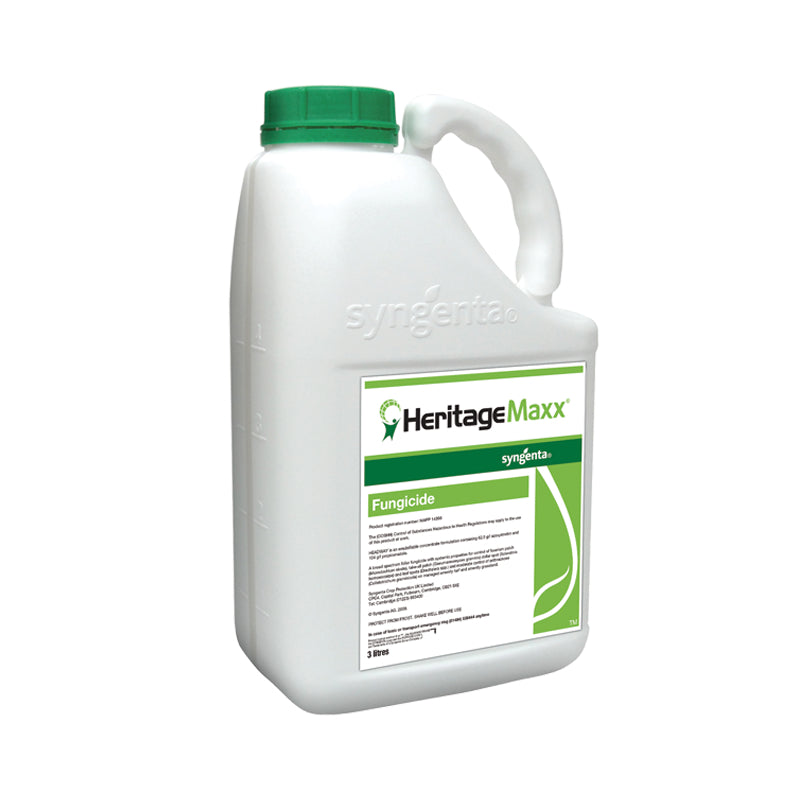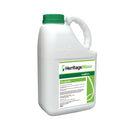Description
| Product overview | |
|---|---|
| Product type | Fungicide |
| Product name | HeritageMaxx® |
| MAPP No. | 18246 |
| Active substances | 95 g/l Asoxystrobin |
| Formulation | Dispersible concentrate |
| Areas of use | Managed amenity turf |
| Amateur/Professional | Professional |
| Role in protection | Preventative & Anti-sporulent |
| Phytomobility | Acropetal penetrant |
| Mode of action group | QoI-fungicide |
Heritage Maxx Turf Disease Control
HeritageMaxx® is a broad spectrum strobilurin systemic fungicide in an easy to use liquid formulation which provides fast activity against turf disease pathogens.
The liquid formulation, HeritageMaxx®, enables both leaf and root absorption ensuring maximum uptake and use by the plant. Rapid movement through the plant ensures that the active substance is transported to the site of infection and begins to control disease pathogens before damage is caused.
HeritageMaxx® can be used preventatively when conditions are favourable for the target disease. It can also be used as an anti-sporulent, to prevent further spread of infection when the pathogen is already active.
The systemic movement of the active substance upwards through the plant provides effective protection good longevity. HeritageMaxx® also has the unique advantage of root uptake, in addition to foliar uptake, meaning that more of the active substance can be fully utilised by the plant.
Target species
| Pathogen triggers | |||||
|---|---|---|---|---|---|
| Pathogen | Temperature | Moisture | Nutrition | Sward | Other |
| Anthracnose | - | Drought stress Poor drainage |
Low fertility | Excessive thatch | Close mowing Excessive traffic |
| Brown patch | > 21°C | Surface humidity; Extended periods of leaf wetness | Excess N Deficient P Deficient K |
||
| Fairy rings | Hydrophobic residues Drought |
Deficient N | Infrequent aeration | ||
| Leaf spot | 15-18°C | Surface humidity Drought stress |
Deficient or excess N | Excessive thatch | Low mowing height |
| Melting out | 10-21°C | Leaf wetness | Excess N | Thatch build-up Close mowing |
Shaded areas |
| Microdochium | < 15°C | Water logged soil Surface humidity |
Low K | Excessive foliar growth Thatch build-up |
Heavy traffic |
| Rust | Extended leaf wetness Drought stress |
Deficient N | Low light intensity Infrequent mowing |
||
| Take-all | < 21°C | Wet weather Poor drainage Over irrigation |
Excessive N | Excessive thatch | Low mowing heights |
Instructions for use
| Maximum treatments | Application interval | Max individual dose | Water volume | Application method |
|---|---|---|---|---|
| 4 per annum | 2 weeks (minimum) | 2.5 L/ha | 125 - 1000 L/ha | Boom or knapsack sprayer |
Where to use: For use on managed amenity turf: Areas of frequently mown intensively managed turf including all types of sports turf, golf greens, tees and fairways.
When to use: Can be applied at any time of the year when conditions are favourable for disease development (see trigger points for disease above).
For best results apply as a preventative treatment at the earliest stages of disease symptom expression.
How to use:
For boom spraying using a vehicle mounted hydraulic sprayer:
- Half fill the spray tank with water
- Begin agitation
- Add the required amount of HeritageMaxx® to the tank
- Complete filling
- Continue agitation until spraying is completed
For spot treatments using a knapsack or hand-held sprayer:
- Half fill the spray tank with clean water
- Add the required quantity of Heritage® to the tank
- Complete filling and mix thoroughly
- Use immediately
Additional information
- Prevent spray drift on to surrounding areas
- Do not apply when ground is frozen or during drought
- Do not allow direct spray from horizontal boom sprayers to fall within 5 m of the top of the bank of a waterbody (unless a LERAP permits a narrower buffer zone)
Active substances
Azoxystrobin
Bio-Chemical Mode of Action: Azoxystrobin belongs to the QoI class of fungicides (Quinone outside Inhibitors).
QoI's work by blocking the pathogens ability to produce energy through the transfer of electrons.
Mobility: Azoxystrobin is an acropetal penetrant which means that after application the fungicide diffuses through the cuticle and is translocated within the xylem (water conducting tissues) upwards through the plant.
Water potential determines the speed of movement and therefore the fungicide moves more rapidly to the leaf tips in conditions which also favour rapid transpiration.
Application timing: Azoxystrobin is best applied preventatively when disease risk is high but symptoms on the leaf are not yet visible. It can also be used when the pathogen is active as an anti-sporulant to prevent further spread of the infection.
Resistance: QoI fungicides have a highly specific mode of action in which only one biochemical site is targeted within the fungal cell. Therefore resistance can occur from just one mutation of that single site.
QoI fungicides must be alternated with products with a different mode of action. Using a QoI fungicide at the earliest stages of disease development as a preventative treatment will also help to reduce the risk of resistance.
Safe Use of Pesticides
The purchaser and/or end users are responsible for ensuring that these products are used in line with industry Approved Codes of Practice. All operators must be trained and certificated in using and applying any Ministry Approved professional product.
Please be aware that by proceeding you are purchasing a professional pesticide product.
You must ensure the end user of these products complies with the DEFRA/HSE Code for the Safe use of Pesticides:
"By law, everyone who uses pesticides professionally must have received adequate training in using pesticides safely and be skilled in the job they are carrying out."
For further information regarding Heritage Maxx Turf Disease Control 3L, please contact our technical sales team on 01902 440250.
Technical Information
Delivery and Returns
Delivery charge (if applicable) applied at checkout. Next working day delivery is available on some products, as an option on orders placed before 1pm - excludes festive season & bank holidays. Please note deliveries to Highlands, Cornwall and more remote areas may take longer. Surcharges apply for non mainland locations, call for more information - More delivery information.
We require deliveries to be signed for. If no one is available to sign for your delivery, you may request it is left in a safe place by leaving a signed note for the driver, requesting the item is left without a signature. Please note that this is left at your own risk and at the driver's discretion.
For large orders, please be aware that if you require a smaller 7.5 tonne lorry, the maximum weight for pallets is 750 kg - otherwise the standard pallet size limit of 1000 kg applies.
Please note:
- For deliveries that require a pallet, the pallet/packaging itself is the customer's responsibility and will not be uplifted or taken upon delivery.
- Deliveries are kerb side only.
- It is possible a pallet order can be delivered on a vehicle up to the size of a 26T lorry.
If you have any access restrictions for lorries or large vehicles please speak to our sales team on 01902 440250.
Collection from our Telford, Shropshire, Trade Counter is available for this product - More collections information.
Safe use of pesticides
The purchaser and/or end users are responsible for ensuring that these products are used in line with industry Approved Codes of Practice. All operators must be trained and certificated in using and applying any Ministry Approved professional product.
Please be aware that by proceeding you are purchasing a professional pesticide product.
You must ensure the end user of these products complies with the DEFRA/HSE Code for the Safe use of Pesticides:
"By law, everyone who uses pesticides professionally must have received adequate training in using pesticides safely and be skilled in the job they are carrying out."





